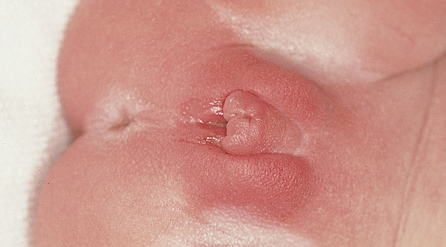Chapter 41 Gynaecological problems in childhood and adolescence
INTERSEX
Congenital adrenal hyperplasia (CAH)
This condition affects one in 10 000 neonates and is due to a group of enzyme defects which prevent the synthesis of cortisone from progesterone. The lack of circulating cortisone permits the hypothalamus–pituitary to release quantities of corticotrophins, which stimulate the adrenal gland to secrete androgens, with resulting virilization of the external genitals (Fig. 41.1).
Other causes of intersex
Gonadal dysgenesis
There are two varieties of this condition, pure gonadal dysgenesis and Turner’s syndrome.




